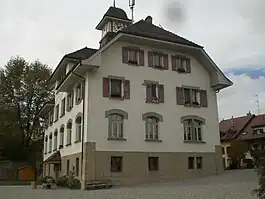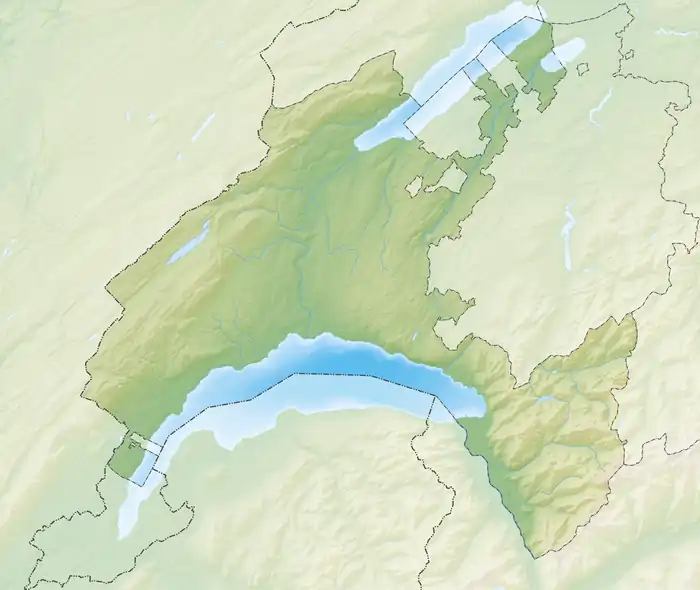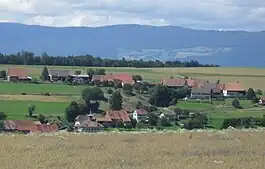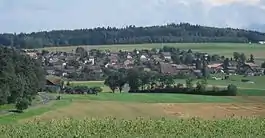Montanaire | |
|---|---|
 Saint-Cierges village school | |
.svg.png.webp) Coat of arms | |
Location of Montanaire | |
 Montanaire  Montanaire | |
| Coordinates: 46°40′N 6°44′E / 46.667°N 6.733°E | |
| Country | Switzerland |
| Canton | Vaud |
| District | Gros-de-Vaud |
| Government | |
| • Mayor | Syndic |
| Area | |
| • Total | 33.48 km2 (12.93 sq mi) |
| Population (31 December 2018)[2] | |
| • Total | 2,683 |
| • Density | 80/km2 (210/sq mi) |
| Time zone | UTC+01:00 (Central European Time) |
| • Summer (DST) | UTC+02:00 (Central European Summer Time) |
| Postal code(s) | 1063 / 1064 / 1409 / 1410 / 1515 |
| SFOS number | 5693 |
| Surrounded by | Boulens, Moudon, Sottens |
| Website | http://www.montanaire.ch Profile (in French), SFSO statistics |
Montanaire (French pronunciation: [mɔ̃tanɛʁ]) is a municipality in the district Gros-de-Vaud in the canton of Vaud in Switzerland. The municipalities of Chapelle-sur-Moudon, Correvon, Denezy, Martherenges, Neyruz-sur-Moudon, Peyres-Possens, Saint-Cierges, Thierrens and Chanéaz merged on 1 January 2013 into the new municipality of Montanaire.[3]
History
Chapelle-sur-Moudon is first mentioned in 1177 as Capellam. In 1228 it was mentioned as Capella Vualdana. Under Bernese administration, it was known as Chapelle Vaudanne. After the creation of the Canton of Vaud (1798) it was known as Chapelle (VD) until 1953.[4] Correvon is first mentioned in 1166 as Correuont.[5] Denezy is first mentioned in 929 as villare Donaciaco. In 1142 it was mentioned as Danisei.[6] Martherenges is first mentioned in the 15th Century as Martherenges.[7] Neyruz-sur-Moudon is first mentioned in 1147 as Noeruls and Nuruls. It was first called Neyruz-sur-Moudon in 1953.[8] Peyres is first mentioned in 1200 as Pairi. Possens was mentioned in 1230 as Pussens.[9] Saint-Cierges is first mentioned around 1145-54 as de sancto Sergio. In 1166 it was mentioned as de sancto Ciriaco.[10] Thierrens is first mentioned around 1004-07 as Teoderinco.[11] Chanéaz is first mentioned in 1184 as Chafneya.[12]
Geography



The former municipalities that make up Montanaire had an area of 33.5 km2 (12.93 sq mi).[13] Eight of the former municipalities came from the Gros-de-Vaud District, while Chanéaz was from the Jura-Nord Vaudois District.
Chapelle-sur-Moudon had an area, as of 2009, of 4.6 square kilometers (1.8 sq mi). Of this area, 3.77 km2 (1.46 sq mi) or 81.4% is used for agricultural purposes, while 0.6 km2 (0.23 sq mi) or 13.0% is forested. Of the rest of the land, 0.3 km2 (0.12 sq mi) or 6.5% is settled (buildings or roads).[14] The former municipality is located on the left side of the Broye valley. It consists of the village of Chapelle-sur-Moudon and the hamlet of Combe.
Correvon had an area, as of 2009, of 2.2 square kilometers (0.85 sq mi). Of this area, 1.86 km2 (0.72 sq mi) or 83.0% is used for agricultural purposes, while 0.28 km2 (0.11 sq mi) or 12.5% is forested. Of the rest of the land, 0.05 km2 (12 acres) or 2.2% is settled (buildings or roads).[14] The former municipality is located on a plateau between the Broye and Mentue rivers.
Denezy had an area, as of 2009, of 3.8 square kilometers (1.5 sq mi). Of this area, 2.73 km2 (1.05 sq mi) or 72.0% is used for agricultural purposes, while 0.88 km2 (0.34 sq mi) or 23.2% is forested. Of the rest of the land, 0.2 km2 (0.077 sq mi) or 5.3% is settled (buildings or roads).[14] The former municipality is located on the road between Lausanne and Estavayer.
Martherenges had an area, as of 2009, of 0.8 square kilometers (0.31 sq mi). Of this area, 0.5 km2 (0.19 sq mi) or 60.2% is used for agricultural purposes, while 0.29 km2 (0.11 sq mi) or 34.9% is forested. Of the rest of the land, 0.04 km2 (9.9 acres) or 4.8% is settled (buildings or roads).[14] The small former municipality is located on a hill on the left side of the Broye valley.
Neyruz-sur-Moudon had an area, as of 2009, of 3.5 square kilometers (1.4 sq mi). Of this area, 2.46 km2 (0.95 sq mi) or 69.9% is used for agricultural purposes, while 0.93 km2 (0.36 sq mi) or 26.4% is forested. Of the rest of the land, 0.12 km2 (30 acres) or 3.4% is settled (buildings or roads) and 0.01 km2 (2.5 acres) or 0.3% is unproductive land.[14] The former municipality is located along the Moudon to Yverdon-les-Bains road. It consists of the haufendorf village (an irregular, unplanned and quite closely packed village, built around a central square) of Neyruz-sur-Moudon and the settlements of La Praire, Les Rutannes and Le Moulin Tardy.
Peyres-Possens had an area, as of 2009, of 1.9 square kilometers (0.73 sq mi). Of this area, 0.94 km2 (0.36 sq mi) or 49.0% is used for agricultural purposes, while 0.76 km2 (0.29 sq mi) or 39.6% is forested. Of the rest of the land, 0.19 km2 (0.073 sq mi) or 9.9% is settled (buildings or roads), 0.01 km2 (2.5 acres) or 0.5% is either rivers or lakes.[14] The former municipality is located on a hilly plateau in the mid-Jorat to the right of the Mentue river. It consists of the villages of Peyres and Possens.
Saint-Cierges had an area, as of 2009, of 6.4 square kilometers (2.5 sq mi). Of this area, 3.94 km2 (1.52 sq mi) or 61.2% is used for agricultural purposes, while 2.18 km2 (0.84 sq mi) or 33.9% is forested. Of the rest of the land, 0.31 km2 (0.12 sq mi) or 4.8% is settled (buildings or roads) and 0.02 km2 (4.9 acres) or 0.3% is unproductive land.[14] The former municipality is located on a plateau in the Jorat between the Broye and Mentue rivers. It consists of the village of Saint-Cierges and the hamlets of Corrençon, Pré-de-Place and Solitude.
Thierrens had an area, as of 2009, of 8.7 square kilometers (3.4 sq mi). Of this area, 6.2 km2 (2.4 sq mi) or 71.1% is used for agricultural purposes, while 1.97 km2 (0.76 sq mi) or 22.6% is forested. Of the rest of the land, 0.57 km2 (0.22 sq mi) or 6.5% is settled (buildings or roads).[14] The former municipality is located at the crossroads of the Moudon-Yverdon and Echallens-Payerne roads.
Chanéaz had an area, as of 2009, of 1.4 square kilometers (0.54 sq mi). Of this area, 1.01 km2 (0.39 sq mi) or 72.7% is used for agricultural purposes, while 0.36 km2 (0.14 sq mi) or 25.9% is forested. Of the rest of the land, 0.04 km2 (9.9 acres) or 2.9% is settled (buildings or roads).[14] The former municipality is located in the northern Jorat plateau with a small enclave between Correvon and Vuissens.
Demographics
The total population of Montanaire (as of December 2020) is 2,777.[15]
Historic population
The historical population is given in the following chart:[16]

Sights
The entire village of Denezy is designated as part of the Inventory of Swiss Heritage Sites.[17]
Weather
Thierrens has an average of 126.5 days of rain or snow per year and on average receives 1,094 mm (43.1 in) of precipitation. The wettest month is June during which time Thierrens receives an average of 111 mm (4.4 in) of rain or snow. During this month there is precipitation for an average of 11.3 days. The month with the most days of precipitation is May, with an average of 13.2, but with only 102 mm (4.0 in) of rain or snow. The driest month of the year is February with an average of 76 mm (3.0 in) of precipitation over 10.2 days.[18]
References
- ↑ "Arealstatistik Standard - Gemeinden nach 4 Hauptbereichen". Federal Statistical Office. Retrieved 13 January 2019.
- ↑ "Ständige Wohnbevölkerung nach Staatsangehörigkeitskategorie Geschlecht und Gemeinde; Provisorische Jahresergebnisse; 2018". Federal Statistical Office. 9 April 2019. Retrieved 11 April 2019.
- ↑ Amtliches Gemeindeverzeichnis der Schweiz published by the Swiss Federal Statistical Office (in German) accessed 2 January 2013
- ↑ Chapelle-sur-Moudon in German, French and Italian in the online Historical Dictionary of Switzerland.
- ↑ Correvon in German, French and Italian in the online Historical Dictionary of Switzerland.
- ↑ Denezy in German, French and Italian in the online Historical Dictionary of Switzerland.
- ↑ Martherenges in German, French and Italian in the online Historical Dictionary of Switzerland.
- ↑ Neyruz-sur-Moudon in German, French and Italian in the online Historical Dictionary of Switzerland.
- ↑ Peyres-Possens in German, French and Italian in the online Historical Dictionary of Switzerland.
- ↑ Saint-Cierges in German, French and Italian in the online Historical Dictionary of Switzerland.
- ↑ Thierrens in German, French and Italian in the online Historical Dictionary of Switzerland.
- ↑ Chanéaz in German, French and Italian in the online Historical Dictionary of Switzerland.
- ↑ Arealstatistik Standard - Gemeindedaten nach 4 Hauptbereichen
- 1 2 3 4 5 6 7 8 9 Swiss Federal Statistical Office-Land Use Statistics 2009 data (in German) accessed 25 March 2010
- ↑ "Ständige und nichtständige Wohnbevölkerung nach institutionellen Gliederungen, Geburtsort und Staatsangehörigkeit". bfs.admin.ch (in German). Swiss Federal Statistical Office - STAT-TAB. 31 December 2020. Retrieved 21 September 2021.
- ↑ Federal Statistical Office STAT-TAB Bevölkerungsentwicklung nach Region, 1850-2000 Archived 2012-03-17 at the Wayback Machine (in German) accessed 29 January 2011
- ↑ "Kantonsliste A-Objekte". KGS Inventar (in German). Federal Office of Civil Protection. 2009. Archived from the original on 28 June 2010. Retrieved 25 April 2011.
- ↑ "Temperature and Precipitation Average Values-Table, 1961-1990" (in German, French, and Italian). Federal Office of Meteorology and Climatology - MeteoSwiss. Archived from the original on 27 June 2009. Retrieved 8 May 2009., the Thierrens weather station elevation is 770 meters above sea level.